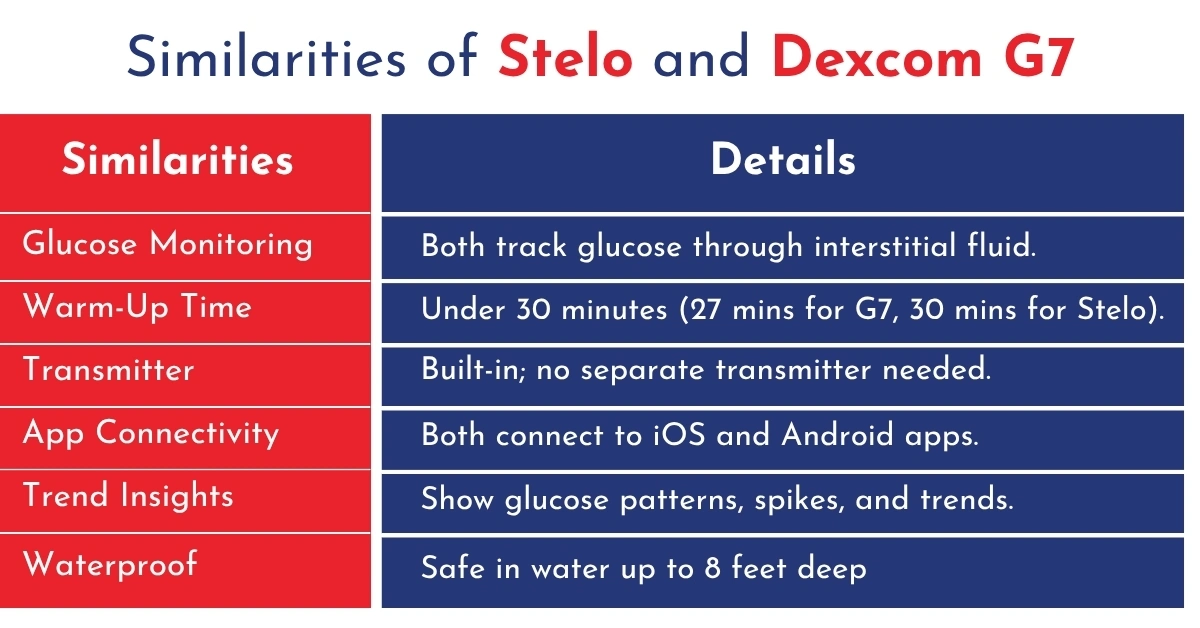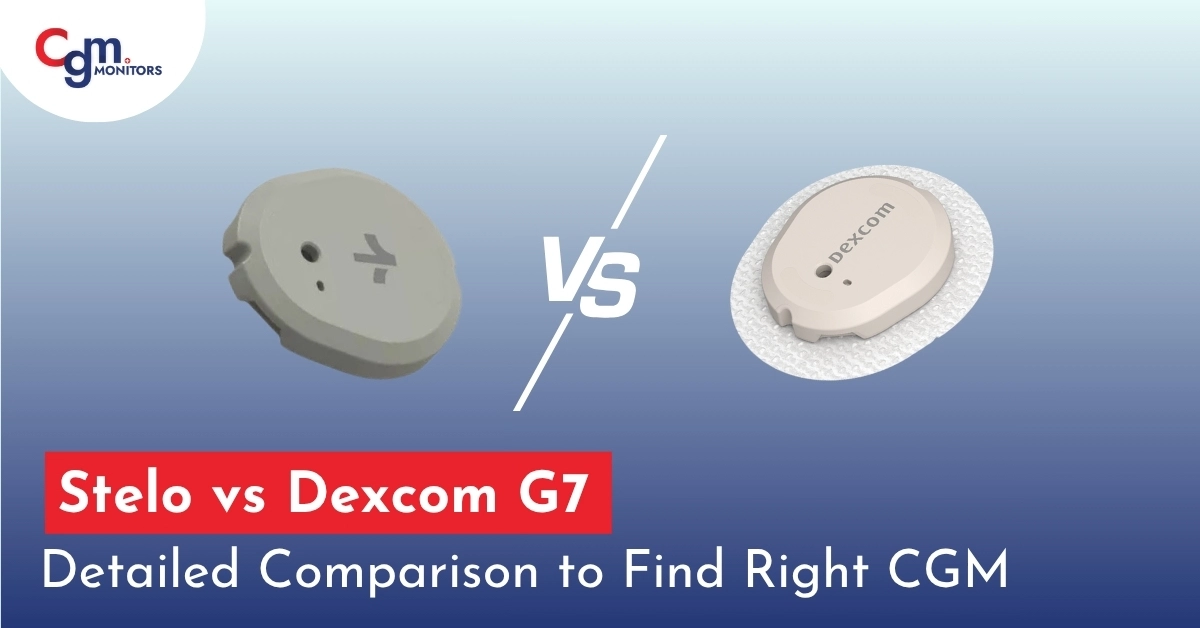Table of content
Stelo is a biosensor that does not require a prescription, is available over-the-counter, and lasts for up to 15 days. The Dexcom G7 requires a prescription and lasts for up to 10 days, with a 12-hour grace period. With that said, Stelo may sound more beneficial; nonetheless, remember that the pros come with cons, and to understand all the positives and negatives of both glucose sensors, let’s dive into Stelo vs Dexcom G7.
Stelo and Dexcom G7 Comparison
Among the major differences between Dexcom G7 and Stelo are the eligibility criteria, availability, accuracy, alerts (especially the low glucose alerts), and AID compatibility.
Eligibility, Availability, Accuracy, Alerts, and AID Compatibility of Stelo
The following are all the major aspects you may want to know about Stelo:
- Eligibility: Stelo is a biosensor indicated for people aged 18 and above who are not on insulin, i.e., type 2 diabetics (not on insulin), or anyone who wants to have good metabolic health. Moreover, there are no insurance coverage details on this biosensor yet.
- Availability: This biosensor is available over the counter (requires no prescription).
- Accuracy: As per the company, when compared to gold testing (fingerstick test), Stelo was found to be about 93% accurate. Some sources suggest that Stelo has a MARD (mean absolute relative difference) of 9.2%.
- IMP: The lower the MARD, the better the accuracy.
- Alerts: While Stelo does offer alerts, they are limited and are not specifically for saving you from adverse low or high blood sugar events.
- AID Compatibility: Stelo is not indicated for diabetics on insulin; it cannot be connected with automatic insulin delivery (AID) systems either.
Eligibility, Availability, Accuracy, Alerts, and AID Compatibility of Dexcom G7
The following are the major aspects of Dexcom G7 continuous glucose monitoring sensors:
- Eligibility: Indicated for individuals aged 2 and above with type 2, type 1, or gestational diabetes. Insurance coverage is available.
- Availability: Requires a prescription from your doctor.
- Accuracy: With a MARD value of 7.8%, Dexcom G7 still stays strong for people who are on insulin.
- Alerts: Not just high and low alerts, the Dexcom G7 sensor comes with predictive low alerts, especially saving you from adverse hyperglycemic events.
- AID Compatible: The G7 sensors are AID compatible and can be connected to some of the latest AID systems in the USA, e.g., Omnipod 5.
While the above are the most concerning aspects for someone looking to add ease to their diabetes management, individuals who do not prefer to even carry their phone may find it suitable to opt for a Dexcom G7 that offers a direct-to-watch feature, allowing you to leave the phone behind whenever you like.
Similarities of Stelo and Dexcom G7
- Glucose Monitoring Principle: Both sensors measure glucose continuously from interstitial fluid.
- Warm-up time: With 27 minutes for Dexcom G7 and 30 mins for Stelo, the warm-up time (before readings begin) of both sensors is under 30 minutes.
- External Transmitter: Neither Stelo nor Dexcom G7 requires a separate transmitter. Both come with built-in transmitters.
- Apps/smartphone connectivity: Both sensors have companion mobile apps (iOS, Android).
- Trend & pattern analytics: Stelo and Dexcom G7 both allow users to see glucose trends, spikes, and behavior correlations (food, exercise).
- Waterproof: Dexcom G7 and Stelo both can be submerged in water up to 8 feet.
- Still confused? Feel free to comment down, and our representatives at CGM Monitors shall be more than happy to assist.

Which One Should You Choose: Dexcom G7 or Stelo
-
If you are type 2 diabetic or manage your sugar level with diet/medication and not using insulin, Dexcom Stelo OTC is likely an excellent choice. It gives you insights, helps you track how your lifestyle impacts glucose, and provides easier access with possibly fewer insurance hurdles.
-
If you are type 2 or type 1 diabetic and manage your glucose level with insulin, or have frequent episodes of low blood sugar, go for Dexcom G7. The extra feature set is worth it.
Conclusion:
Stelo, a no-prescription and over-the-counter biosensor, is suitable for people who want to monitor their glucose levels but do not experience extreme low or high glucose. While the Dexcom G7 is suitable for a wide range of individuals aged 2 and above who are living with diabetes, who may require alerts to save themselves from extreme hypo or hyperglycemic events.
Disclaimer: This blog is for informational purposes only and does not constitute medical, legal, or professional advice. While we strive for accuracy, errors or omissions may occur.
Some images in this blog may be AI-generated or for illustrative purposes only. Device images belong to their respective manufacturers and are used here for reference. Actual products may vary.
Frequently Asked Questions
Is Stelo available yet, and when is the official release date?
Stelo is set to be launched in the U.S. in late 2025, pending FDA clearance. It’s designed mainly for non-diabetic or prediabetic users who want to monitor glucose trends for wellness and lifestyle tracking.
Does Stelo require a prescription, or can you buy it over the counter?
Unlike the Dexcom G7, which requires a prescription, Stelo will be available over the counter, making it more accessible for people without diabetes who still want real-time glucose insights.
How much does the Stelo CGM cost compared to the Dexcom G7?
The Stelo CGM is 99 dollars in total which is less than the Dexcom G7, appealing to wellness users and those without insurance coverage. Pricing details will be announced at launch.
Is Stelo covered by Medicare or private insurance?
Since Stelo targets non-diabetic users, it won’t initially be covered by Medicare or most insurance plans, while the Dexcom G7 remains covered for eligible diabetic patients.
Does the Stelo provide real-time glucose readings like Dexcom G7?
Yes, Stelo offers continuous real-time glucose readings, just like the Dexcom G7, allowing users to monitor how meals, exercise, and sleep affect their glucose levels instantly.
Can you wear the Stelo or Dexcom G7 through TSA or airport security?
Both devices are TSA-friendly. Users can safely wear them through airport security scanners without removing the sensors or transmitters.
How reliable are Stelo glucose readings compared to Dexcom G7?
Early reports suggest Stelo offers competitive accuracy, though Dexcom G7 still holds the edge in medical-grade precision. Stelo focuses more on lifestyle tracking than clinical management.
Does Stelo integrate with devices like Oura Ring or Apple Health?
Yes, Stelo is expected to sync with popular wellness apps like Apple Health, Fitbit, and Oura Ring, allowing seamless tracking of glucose alongside sleep, activity, and heart metrics.
What are users and early testers saying about the Stelo CGM?
Early testers describe Stelo as lightweight, easy to apply, and insightful for diet tracking, though some note it’s less medical-grade precise than Dexcom G7.







Write a comment
Your email address will not be published. All fields are required